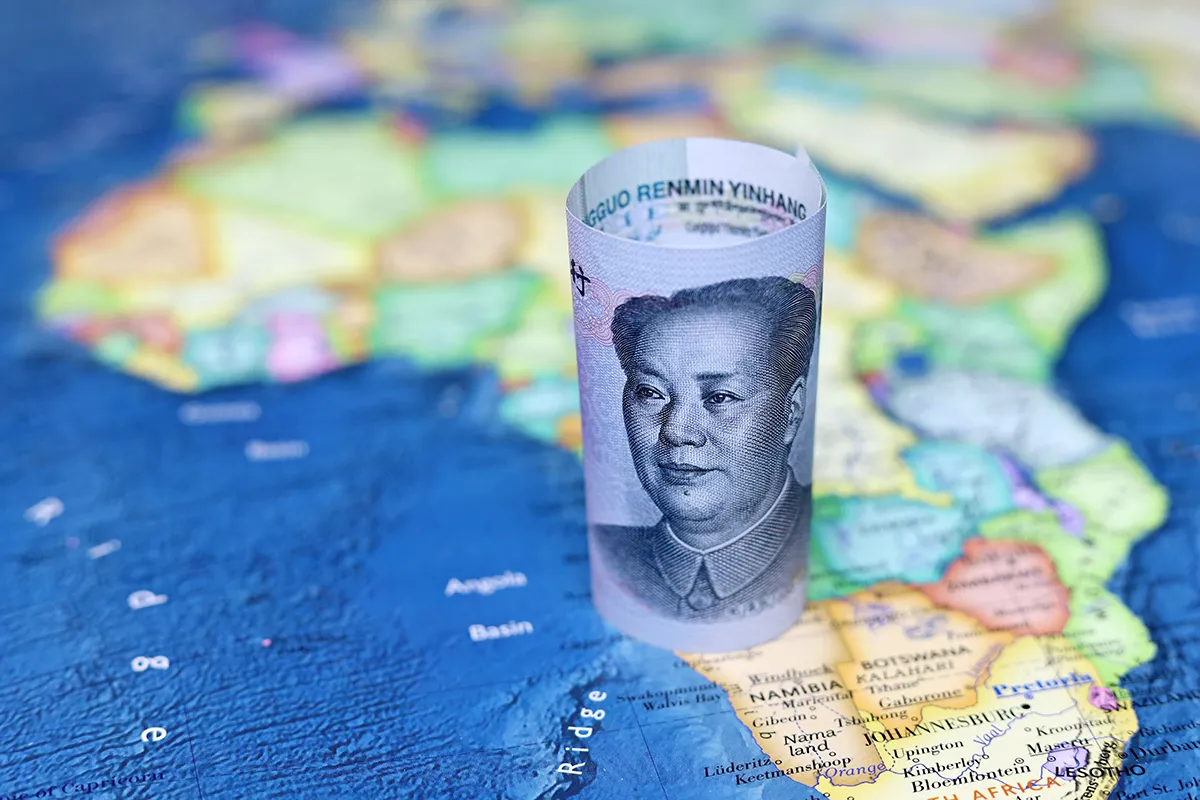The global debt landscape is undergoing a seismic shift as developing nations from Kenya to Sri Lanka increasingly turn their backs on traditional dollar-denominated loans in favor of Chinese yuan financing. While the immediate cost savings appear attractive, the International Monetary Fund has issued a stern warning about the potential long-term currency risks that could destabilize already fragile economies.
This financial pivot represents more than just a technical debt management strategy—it marks a fundamental realignment in how emerging markets engage with global capital flows and signals China’s growing influence in international finance through its Belt and Road Initiative and broader economic diplomacy.
Build the future you deserve. Get started with our top-tier Online courses: ACCA, HESI A2, ATI TEAS 7, HESI EXIT, NCLEX-RN, NCLEX-PN, and Financial Literacy. Let Serrari Ed guide your path to success. Enroll today.
Kenya’s Railway Debt: A $215 Million Annual Saving
Kenya has emerged as one of the most prominent early adopters of yuan debt conversion, transforming its controversial Chinese-financed Standard Gauge Railway project from a dollar liability into a yuan obligation. The restructuring has delivered tangible results: approximately $215 million in annual payment reductions, providing much-needed fiscal breathing room for a government that has faced mounting pressure over its debt sustainability.
The Standard Gauge Railway, connecting the port city of Mombasa to the capital Nairobi, was initially financed through dollar-denominated loans from Chinese state banks. As the shilling weakened against the dollar over recent years, Kenya’s repayment burden grew heavier. By converting to yuan, the East African nation has effectively hedged against further dollar appreciation while simultaneously benefiting from lower Chinese interest rates.
This restructuring comes at a critical juncture for Kenya, which has been grappling with elevated debt levels that reached concerning proportions relative to GDP. President William Ruto’s administration has made debt management a cornerstone of its economic policy, and the yuan conversion aligns with broader efforts to reduce the country’s external financing costs.
Ethiopia’s Eurobond Default and $5.38 Billion China Restructuring
Ethiopia’s situation is even more precarious. After defaulting on a $1 billion Eurobond in late 2023, the Horn of Africa nation has been scrambling to restructure its external obligations. Now, Ethiopian officials are in advanced negotiations to restructure $5.38 billion owed to China under the G20 Common Framework, a multilateral mechanism designed to provide debt relief to the world’s poorest countries.
Ethiopia’s economic challenges have been compounded by internal conflict, particularly the devastating war in the Tigray region that ended in 2022, and the ongoing effects of drought and food insecurity. The country’s foreign exchange reserves have been critically depleted, making debt service in hard currencies increasingly difficult. Converting Chinese debt to yuan offers a potential lifeline, though it comes with its own set of complications.
The attraction for Ethiopia is clear: yuan bonds issued in 2024 have carried average yields near 2.4%, roughly half the rate demanded for dollar-denominated debt from African frontier markets. This spread represents hundreds of millions of dollars in potential annual savings—money that could be redirected toward essential services and development priorities in one of Africa’s most populous nations.
The IMF’s Measured Warning
Despite the apparent advantages, the International Monetary Fund has adopted a cautious stance toward the yuan conversion trend. In carefully worded statements, Fund officials have acknowledged that such transactions may offer a proactive approach to managing debt costs, but they’ve emphasized that the strategy could expose vulnerable economies to new forms of financial volatility.
“While these transactions may lower costs, they can also introduce currency risks depending on their structure,” IMF officials noted, stressing that any pivot toward yuan-denominated obligations should be firmly grounded in comprehensive medium-term debt and reserve management strategies.
The IMF’s concern centers on several key risks. First, most African economies conduct the vast majority of their international trade in dollars, not yuan. Their export revenues—whether from coffee, tea, minerals, or tourism—are predominantly dollar-denominated. Creating a mismatch between revenue currencies and debt obligations can introduce new vulnerabilities, particularly if the yuan appreciates against local currencies or if China’s economic trajectory shifts unexpectedly.
Second, the yuan, despite China’s efforts to internationalize it, remains far less liquid in global markets than the dollar. This limited liquidity could create challenges if debtor nations need to hedge their exposures or manage sudden shifts in currency valuations. The yuan’s value is also more tightly controlled by Chinese authorities through the People’s Bank of China, introducing a different type of policy risk than the market-driven dollar.
One decision can change your entire career. Take that step with our Online courses in ACCA, HESI A2, ATI TEAS 7, HESI EXIT, NCLEX-RN, NCLEX-PN, and Financial Literacy. Join Serrari Ed and start building your brighter future today.
Beyond Africa: The Global Yuan Wave
The yuan financing trend extends well beyond the African continent. Sri Lanka, which experienced a catastrophic economic collapse and debt default in 2022, is now seeking the yuan equivalent of $500 million to finance a highway project that was originally planned with dollar funding. The South Asian nation’s pivot toward yuan reflects both its deepening economic relationship with China and the practical constraints it faces in accessing traditional Western capital markets following its default.
In Europe, Hungary—a member of the European Union but one that has cultivated close ties with Beijing—is preparing to issue panda bonds worth five billion yuan. Panda bonds are yuan-denominated bonds issued by non-Chinese entities in China’s domestic market, representing another avenue through which nations can tap into Chinese savings and reduce their reliance on dollar financing.
These developments collectively signal a gradual but meaningful erosion of dollar dominance in certain segments of international finance, particularly in infrastructure financing and sovereign debt management among developing nations.
Reserve Management Challenges
One of the most complex aspects of yuan debt adoption involves reserve management. Deepak Dave, an analyst at Autonomi Capital, has highlighted that yuan borrowing effectively compels governments to diversify their foreign exchange reserves toward the Chinese currency. This represents a significant operational challenge for central banks that have traditionally held reserves overwhelmingly in dollars, euros, and other freely convertible major currencies.
For countries whose export sectors are dollar-oriented—selling commodities, agricultural products, or services primarily to Western markets—holding large yuan reserves creates a potential mismatch. If a crisis emerges and foreign exchange reserves need to be deployed to stabilize the local currency or service urgent obligations, having reserves in yuan rather than dollars could prove problematic, particularly given the yuan’s limited convertibility and the capital controls that China maintains.
Building yuan reserves also requires accessing Chinese financial markets, which operate under different regulatory frameworks than Western markets. Central bank reserve managers must develop new expertise, establish new relationships with Chinese counterparties, and navigate the unique characteristics of China’s banking system and capital markets.
Beijing’s Strategic Vision
For China, the yuan internationalization drive represents a core strategic objective that President Xi Jinping has pursued with increasing vigor. The Belt and Road Initiative, launched in 2013, has served as a primary vehicle for expanding yuan usage by financing infrastructure projects across Asia, Africa, and Latin America.
By denominating loans in yuan, China achieves multiple objectives simultaneously. First, it reduces its own currency risk—Chinese banks lend in the currency they naturally have in abundance. Second, it creates sustained demand for the yuan as borrower nations must acquire or earn yuan to service their debts. Third, it gradually builds the financial infrastructure and market practices necessary for the yuan to function as a true reserve currency.
The ultimate prize for Beijing would be to establish the yuan as a genuine alternative to the dollar in international transactions, reducing China’s vulnerability to dollar-based sanctions and financial pressure while expanding Chinese influence over global economic governance. While the yuan still accounts for only a small fraction of global foreign exchange reserves—around 2-3% compared to the dollar’s 58-60%—the trajectory has been steadily upward.
The Debt-Trap Debate
The surge in Chinese lending to developing nations, followed by debt restructuring into yuan obligations, has reignited debates about so-called “debt-trap diplomacy“—the notion that China deliberately extends unsustainable loans to gain strategic leverage over borrower nations.
Proponents of this view argue that projects like Kenya’s Standard Gauge Railway were financially questionable from the outset, with inflated costs and unclear economic returns. When borrowers struggle to repay, China can extract concessions, potentially including access to strategic assets or political alignment on key issues.
Critics of the debt-trap narrative counter that Western institutions and bilateral lenders also have long histories of problematic lending practices in developing countries. They note that Chinese financing often funds infrastructure that these nations desperately need but cannot otherwise access, and that restructuring terms have generally been commercially reasonable rather than predatory.
The truth likely lies somewhere in the middle. Chinese lending practices vary widely by project and country, and motivations blend commercial and strategic considerations. What’s clear is that the accumulation of Chinese debt by developing nations has created new geopolitical dynamics that will shape international relations for years to come.
A Balancing Act with Uncertain Outcomes
For developing nations, the decision to convert dollar debt into yuan obligations represents a classic risk-reward calculation. The immediate benefits are tangible: lower interest rates, reduced annual debt service costs, and improved fiscal flexibility. These advantages can be particularly compelling for countries facing severe budget pressures, like Kenya with its ambitious development agenda or Ethiopia with its post-conflict reconstruction needs.
The longer-term risks, however, are less certain and potentially more consequential. Currency mismatches could amplify rather than reduce vulnerability if yuan-local currency exchange rates move unfavorably. Limited yuan liquidity could create challenges in managing exposures. And deeper financial integration with China could create new forms of economic dependence that constrain policy autonomy.
The IMF’s warning reflects these concerns, urging nations to approach yuan debt conversion not as a quick fix but as part of comprehensive strategies that consider all dimensions of fiscal sustainability, currency risk, and reserve adequacy. The Fund has emphasized that debt management decisions should be integrated with broader economic reforms, including efforts to boost export competitiveness, improve revenue collection, and strengthen public financial management.
Conclusion: Reshaping the Global Financial Order
The pivot toward yuan financing by Kenya, Ethiopia, Sri Lanka, and other developing nations marks a significant moment in the evolution of the international monetary system. While the dollar’s dominance remains overwhelming, the emergence of yuan as a meaningful alternative in specific contexts signals that the post-World War II financial architecture is becoming more multipolar.
For African nations and other developing economies, this diversification offers both opportunities and risks. Cheaper financing can accelerate development and reduce fiscal stress, but it comes with new exposures and potential constraints. Success will depend on how skillfully governments manage these trade-offs and whether they can leverage competition between Western and Chinese financing sources to negotiate better terms overall.
The coming years will reveal whether this yuan wave represents a sustainable shift toward a more balanced global financial system or a risky bet that leaves vulnerable economies more exposed than before. What’s certain is that the choices made today by finance ministers in Nairobi, Addis Ababa, and Colombo will reverberate across the developing world and help determine the future shape of international finance.
For now, as Beijing celebrates another milestone in its yuan internationalization campaign and the IMF sounds notes of caution, borrower nations continue their delicate balancing act—seeking cheaper money today while hoping to avoid deeper currency complications tomorrow. The ultimate outcomes remain uncertain, but the transformation is already underway.
Ready to take your career to the next level? Join our Online courses: ACCA, HESI A2, ATI TEAS 7 , HESI EXIT , NCLEX – RN and NCLEX – PN, Financial Literacy!🌟 Dive into a world of opportunities and empower yourself for success. Explore more at Serrari Ed and start your exciting journey today! ✨
Track GDP, Inflation and Central Bank rates for top African markets with Serrari’s comparator tool.
See today’s Treasury bonds and Money market funds movement across financial service providers in Kenya, using Serrari’s comparator tools.
Photo source: Google
By: Montel Kamau
Serrari Financial Analyst
12th November, 2025
Article, Financial and News Disclaimer
The Value of a Financial Advisor
While this article offers valuable insights, it is essential to recognize that personal finance can be highly complex and unique to each individual. A financial advisor provides professional expertise and personalized guidance to help you make well-informed decisions tailored to your specific circumstances and goals.
Beyond offering knowledge, a financial advisor serves as a trusted partner to help you stay disciplined, avoid common pitfalls, and remain focused on your long-term objectives. Their perspective and experience can complement your own efforts, enhancing your financial well-being and ensuring a more confident approach to managing your finances.
Disclaimer: This article is for informational purposes only and does not constitute financial advice. Readers are encouraged to consult a licensed financial advisor to obtain guidance specific to their financial situation.
Article and News Disclaimer
The information provided on www.serrarigroup.com is for general informational purposes only. While we strive to keep the information up to date and accurate, we make no representations or warranties of any kind, express or implied, about the completeness, accuracy, reliability, suitability, or availability with respect to the website or the information, products, services, or related graphics contained on the website for any purpose. Any reliance you place on such information is therefore strictly at your own risk.
www.serrarigroup.com is not responsible for any errors or omissions, or for the results obtained from the use of this information. All information on the website is provided on an as-is basis, with no guarantee of completeness, accuracy, timeliness, or of the results obtained from the use of this information, and without warranty of any kind, express or implied, including but not limited to warranties of performance, merchantability, and fitness for a particular purpose.
In no event will www.serrarigroup.com be liable to you or anyone else for any decision made or action taken in reliance on the information provided on the website or for any consequential, special, or similar damages, even if advised of the possibility of such damages.
The articles, news, and information presented on www.serrarigroup.com reflect the opinions of the respective authors and contributors and do not necessarily represent the views of the website or its management. Any views or opinions expressed are solely those of the individual authors and do not represent the website's views or opinions as a whole.
The content on www.serrarigroup.com may include links to external websites, which are provided for convenience and informational purposes only. We have no control over the nature, content, and availability of those sites. The inclusion of any links does not necessarily imply a recommendation or endorsement of the views expressed within them.
Every effort is made to keep the website up and running smoothly. However, www.serrarigroup.com takes no responsibility for, and will not be liable for, the website being temporarily unavailable due to technical issues beyond our control.
Please note that laws, regulations, and information can change rapidly, and we advise you to conduct further research and seek professional advice when necessary.
By using www.serrarigroup.com, you agree to this disclaimer and its terms. If you do not agree with this disclaimer, please do not use the website.
www.serrarigroup.com, reserves the right to update, modify, or remove any part of this disclaimer without prior notice. It is your responsibility to review this disclaimer periodically for changes.
Serrari Group 2025












